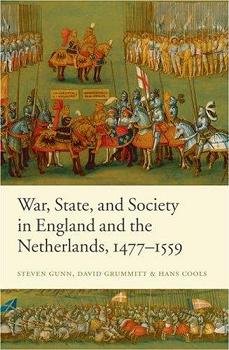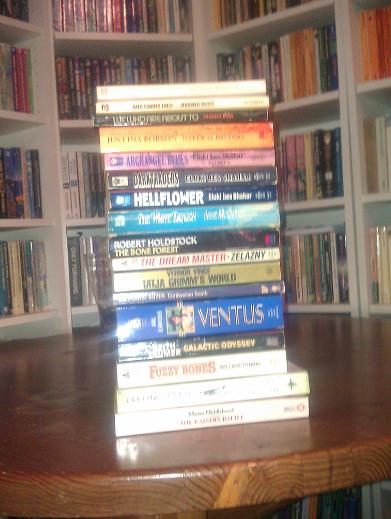Not that there’s anything wrong with that.
Bonus: dubtrot.
Not that there’s anything wrong with that.
Bonus: dubtrot.

War, State and Society in England and the Netherlands, 1477-1559
Steven Gunn, David Grummitt & Hans Cools
395 pages including index
published in 2007
Everything the authors tried to achieve with this book is in the title, but whether they succeeded is another question. Based on a massive research project that was carried out between 1999 and 2002, what the book was intended to be was a comparative study of two roughly similar countries in a period critical to Early Modern European history, to determine the impact of war both on society and the (semi-modern) state. As the authors argue, both England and the Netherlands (meaning what we would now call the Low Countries) were sort of outliers in Europe, neither quite fitting in “conventional narratives of the growth of state power”, not as centralised as other countries and with a greater level of democracy. For English historians, an added advantage of this comparison is that it puts England back into an European context by showing the simularities and differences between the two countries’ experiences.
War, State and Society in England and the Netherlands, 1477-1559 is impressive and interesting but what it lacks is that comparative aspect that the title and introduction promises. It’s more a parallel than a comparative history, with developments in the two countries looked at side by side. So you’d have a section on the defence of towns looking first at how English towns dealt with fortifications, then at how Dutch towns did the same, but nothing much on how they differed or why they did. This lack of analysis wasn’t that big a problem for me personally because I found the subject interesting enough already.

Not the best of pictures, but good enough to show off the books I bought yesterday. And yes, I know I have too many books already, not to mention a fair few library books that need to go back soon. But I can’t help it; every now and then I get the urge and need to get more. What’s nice is when that urge is satisfied, like it was this time. Sometimes you have to let a bookstore lie fallow for a while, not visit for a couple of weeks or months to give it time to surprise you. The secondhand English bookstore near Nieuwmarkt I got all this from certainly did.
From the bottom up: The Kaiser Battle, about the first day of the last German offensive in World War I by Martin Middlebrook, Justina Robson’s Keeping it Real, the William Tuning sequel to H. Beam Piper’s Little Fuzzy novels, a pre stroke Keith Laumer novel I haven’t read yet (Galactic Oddyssey), Karl Schroeder’s debut novel Ventus, Cordwainer Smith’s The Planet Buyers, Tatja Grimm’s World, an early Vernor Vinge novel, a Zelazny novel I didn’t know yet (The Dream Master), Robert Holdstock’s The Bone Forest…
Moving on to the female writers: there’s Ann McCaffrey’s The White Dragon which I foolishly had gotten rid off a few years ago, the first three Eluki Bes Shahar Hellflower space adventure stories and Justina Robson’s debut novel, Natural History which had been on my wishlist for ages.
But the books I’m most happy to have found are at the very top: three Joanna Russ novels: We Who Are About to, And Chaos Died, and The Two of Them. Reading The Female Man last year was a revelation; I hadn’t realised how good Russ was as a writer, rather than as “just” a feminist science fiction writer. Annoyingly, that reputation of being a firebreathing feminist had kept me far too long from trying her novels and then when I did want to read them, I couldn’t find them anywhere. Not anymore.
That’s the question Robert left on my review of Kraken:
Here’s a challenge for you, if you want it. Suppose you had $500 to spend on science books for a high school library, what would you buy? I’ve got a small budget, so I want to get the most bang of the buck
Which books I would recommend? Ben Goldacre’s Bad Science to get some inoculation against quackery. Any of Richard Fortey’s books on evolution and geology, particularly Life and The Earth, but also Trilobite, Chad Orzel’s How to Teach Physics to Your Dog which is a popular science book on quantum physics, any of Ian Stewart’s or Martin Gardner’s books of mathematical puzzles, Gabrielle Walker’s Snowball Earth just to show how cool Earth’s long prehistory has been, any of Richard Dawkin’s recent books in which he doesn’t bang on about religion.
Which books would you recommend?
Radical feminism is a form of feminism that’s, to put it politely, black and white in its view of the battle of the sexes, black and white enough to be able to use that outdated term with a straight face here. Radical feminism attempts to reject all gender roles and anything that smacks of sexual essentialism — men drive like this, but women drive like that — and argues that all such roles are socially defined, part of an overarching male dominated value system that defines women as inferior and which glorifies those characteristics that are stereotypically male and pillorises those that are stereotypically female. The breakdown of these structures and existentialist gender roles is what radical feminism attempts to do.
And if anything breaks down existentialist gender roles, it should be transgender people, shouldn’t it? What after all shows the idiocity of gender existentialism more than somebody who by their very existence shows that physical sexual characteristics does not a man or woman make, that you can be born and raised a man yet know yourself to be a woman or vice versa, let alone those who know themselves to be neither, or both, or something else entirely?
Yet radical feminism has huge problems with this. On the one hand, it insists that transgendered people are victims of exactly the patriarchial society they’re fighting against, confused by the gender essentialist social roles that insist that if you like pink dresses and My Little Pony you’re a girl, to the point that you’d use dangerous hormonal therapies and even surgery to change your physical gender, yet on the other hand it also insists that there’s no such thing as transgender women, just men masquarading as women (and vice versa). Both views are insulting and repulsive to say the least. Either you’re a duped and confused victim of social brainwashing, or you’re a hideous freak trying to fool real women you’re one of them.
This poisonous attitude is even on display in the writings of more moderate radical feminists, of those who have found that it is no longer possible to ignore or laugh off the “problem” of transgender. Which brings me to what inspired this post, radical feminist Nine Deuce’s sincere attempt to find some way in which transgender can be reconciled with radical feminism. She does this by stating her own position on the issue and seems to believe this should offer some way in which radical feminists can positively engage with transgender “activists”. Yet the bigotry is still palpable:
That there are people who feel so uncomfortable with the difference between their sexed bodies and their socialized conception of themselves that they would choose to risk deformity, death, and disability is to be deplored. Women have been conditioned to harm their own bodies in service of a social gender role grounded in misogyny and male supremacy. Radical feminism seeks an end to this practice. Women seeking surgery in order that their bodies will appear like male bodies, or men who undergo surgery in order that their bodies will present as female bodies, face huge psychological and physical risks and social ostracization. Adamantine gender roles are the source of the demand for these medical procedures and the dangers that attend them. Radical feminism also seeks an end to this practice.
That’s the idea of transgender women –transgender men not being of much interest to radical feminism, other options rejected entirely — as brainless victims having to be saved from themselves.
When trans activists bully radical feminists and attempt to force their way into women-only spaces, women should be angry and should speak up — and should express anger when they do speak up — but should do so responsibly and intelligently, so that the radical feminist perspective won’t be written off.
That’s the idea of transgender women as intruders, as charlatans pretending to be female in order to infiltrate “women-only spaces”. There’s a bit of projecting going on here as well, in an earlier comment Nine Deuce made:
Men absolutely loathe and fear trans people. Transmen are seen as intruders, but transwomen are seen as traitors. Men cannot understand why someone born male would choose to take on what they see as a subordinate position in society. It threatens their sense of order in a fundamental way.
Note that this is men, not some men or many men, but men. In Nine Deuce’s worldview, we all hate and loathe transgender men and women.
Meanwhile, it’s becoming clear that this whole exercise is more about a way to improve radical feminism’s image as an ideology that is bigoted towards transgender people, without actually wanting to lose this bigotry, viz:
What cannot be allowed is for the public face of radical feminist theory to appear reactionary, and right now it does.
I think radical feminism has lost that battle. It was a product of second wave feminism, a separatist ideology that has long outlived any merit it once had. For younger women, who grew up in a world in which the ideals second wave feminists fought for have been largely realised and for whom gender and sexual identity has always been a much more fluid thing than radical feminism thought possible, it’s just not an attractive ideology anymore. It battles the wrong things and seems to have no answers to real problems facing women today, welded as it is to a view of gender that’s just as existentialist as the patriarchial system it tries to overthrow.